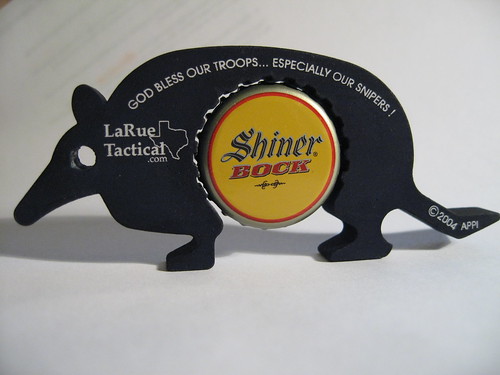
Posted on 04/23/2010 5:19:25 PM PDT by SandRat
FORT POLK, La., April 23, 2010 – It was April 2007 and the early-morning sky was clear as Army sniper Sgt. 1st Class Brandon McGuire and his spotter scanned for insurgents near Forward Operating Base Iskandaryia in Iraq.
"We were observing a stretch of road that had recently been cleared of IEDs [improvised explosive devices]," said McGuire, now the first sergeant of Alpha Troop, 1st Battalion (Airborne), 509th Infantry Regiment that’s based here.
"The area had also seen a lot of mortar activity,” McGuire recalled. “We had several soldiers killed and severely wounded along that stretch of road by IEDs and mortars."
As the two soldiers gazed across the expanse between their hiding place - an abandoned shed - and their target area, they noticed a man in local garb sauntering up and down through a series of canals. When he dug into a canal bank and uncovered a mortar tube, McGuire knew this was a target.
"We called the battalion tactical operations center and reported what we had," said McGuire, who hails from Olathe, Kan. "We were granted permission to engage the target."
However, engaging the target was easier said than done.
"We measured the distance at 1,310 meters," McGuire said. "There was a crosswind of 8-10 knots and a sand storm was heading our way. We didn't have a lot of time."
Yet time was needed. Snipers are trained to make a triangle from a target's chin to his chest, and then aim for that mark. But McGuire's target was moving up and down through canals, making it difficult for the Army marksman to get a clear shot. And, it was necessary to make calculations for windage.
But, McGuire caught a break - there were some children flying kites not far from the target. "We were able to use the kites to help estimate the wind speed at the target," McGuire said. "We watched for almost two hours before the target presented himself in such a way that I was able to get a clear shot."
McGuire said he didn't think he would hit his target with the first shot.
"I was hoping I would get close enough to make an adjustment and hit him with the second shot," McGuire said. "I knew that when I fired there would be a brown out for a couple of seconds - the dust would block my vision - so I was depending on my spotter to let me know where the first round hit."
McGuire took a breath and then squeezed the trigger of his Barrett .50 caliber sniper weapon system. After the dust cleared, McGuire prepared for a second shot, but was unable to find the target.
"I asked my spotter, 'Where is he?'" McGuire recalled. The spotter replied: “I think you got him."
McGuire said that for a couple of seconds there was disbelief on his part. Then it was back to work scanning the sector for targets.
The shot was so effective that no one knew about it, other than McGuire, his spotter - and the target.
"Even the kids flying the kites were oblivious to what happened," McGuire said. "They just kept flying their kites."
McGuire had removed an insurgent who had helped kill and wound American soldiers.
"No one knew who shot him," McGuire said. "Not even the local elders.
The U.S. soldiers in the area gained an immediate benefit with the death of the insurgent, McGuire said.
"We'd had so many soldiers killed and who had lost legs,” he said. “After the shot the daily mortar attacks and IEDs ceased in that area."
McGuire said "the million-dollar shot," as it became known among members of his unit, was a big deal to coalition forces in the area.
"Everyone was congratulating me," he said. "But to me, it seemed like another day in Iraq."
McGuire recently returned from a trip to California to film a segment of an upcoming History Channel special entitled "Sniper: The Deadliest Mission." The two-hour documentary is scheduled to air this fall.
"I spent a couple of hours in an interview, then shot the rest of the day with another sniper," McGuire said. "It was a lot of fun."
McGuire attributes the success of the improbable shot to tactical patience.
"It took us two hours to get the shot picture I needed on the target because of the terrain," he said. "We waited, then finally got the shot. Hitting a human target is not like a deer or something.
"With an animal, you can kind of predict what their movements are going to be, but with a human, you don't know what they are going to do."
I love the ingenuity of our troops!
Ohhhh.....yes I would, just for ballistic analysis of course. :=)
Like this, after flying there and back?
I don’t think that worked as well as reported. The velocity of a .50 BMG wouldn’t allow a lead bullet covered in copper the ability to bounce like that and then penetrate the steel plating.
I understood our pilots aimed for the relatively thin plating over the engine compartment.

Nice shot soldier! Thanks!
Try a laser ruler, the range finder’s little brother. I just got one and used it to measure my house for an insurance evaluation. Absoltely terrific and eliminated the need for a helper with a tape measure.

I love happy endings ;)
I don’t know about the .50 BMG being used today but I sliced open several .50 cal bullets from the WWII era. There was not a bit of lead in them. The brass shell surrounded a stainless steel core. Awesome little things.
Bravo Zulu!
I couldn’t find a thing on the material used for a .50 BMG bullet. I have several cartridges but I always thought they were simply copper over lead except for the black tipped armor piercing.

You or your son are my guess.
laser ruler?
It still - 44 years away - pisses me off to no end that in Marine Corps Boot Camp I fired "Expert" in every pre-qual shoot....but on actual qualifying day, I hiccuped and only made Marksman; didn't even make Sharpshooter...
Pretty much the same thing a couple of years later, just before I got out (woulda been worse, but I was a short-timer) it rained and my eyeglasses got all gooed up and I actually was a Non-Qual.
"Multiple Organisms"
Bravo!
Now that's what I'm talkin about!
HoooAhh!
Sorry to burst you bubble when we're on a .50 cal roll here, but that's an old WW2 myth.
The harassing file from the planes was very valuable though. Combined arms - aircraft strafing the tank (that's gotta sound LOUD inside the tank!) allowing the ground troops the ability to get in position close enough to attack the tank with explosives or a bazooka.
Disclaimer: Opinions posted on Free Republic are those of the individual posters and do not necessarily represent the opinion of Free Republic or its management. All materials posted herein are protected by copyright law and the exemption for fair use of copyrighted works.